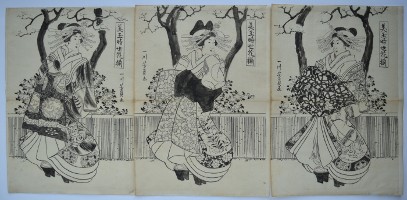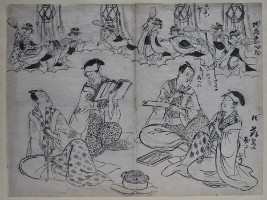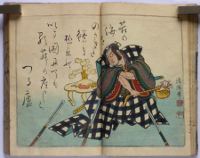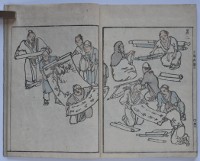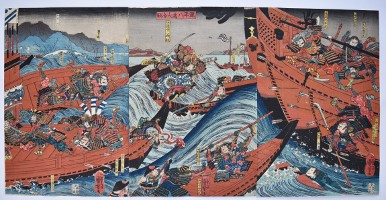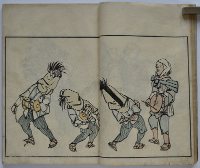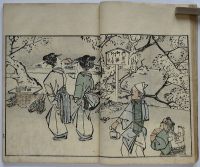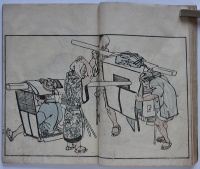Utagawa HIROSHIGE II (1829-1869)

Click here to view image full size.
An original painting, full colour on silk, 37 x 14 in; 94 x 35.5 cms. The pupil of Hiroshige I who gave him the name Shigenobu. Adopted by Hiroshige in 1845 and married his daughter, Otatsu, on Hiroshige’s death. (Later divorcing her around 1865.) Shows a beauty cooling off on the prow of a boat beneath a full moon and the trestles of a bridge. (Probably the Ohashi over the Sumida River.)
In very good condition and possibly his best painting. Signed Hiroshige ga, seal unread.
Status: Available

Click here to view image full size.
Nagasawa ROSETSU (1754-1799)

Click here to view image full size.
An original fan painting, sumi on treated paper, 17 x 6.25 in; 43 x 16 cms. Shows two needlefish (family Belonidae).Rosetsu is considered one of the most important artists of the late Edo period but little is known of his short life – he died at forty-five, apart from the fact that he studied and was one of the top disciples of Maruyama Okyo. He is labelled an “eccentric” painter as he defies easy classification. His brushwork is a tour de force and he is known for his expressive depictions of animals. Signed Rosetsu with his Gyo (fish) seal. Framed and glazed with the fan mounted onto Japanese paper. Good condition, apart from the obvious fan folds.
Status: Available
Utagawa KUNIYOSHI (1797-1861)

Click here to view image full size.
The actor Onoye Kikugoro III as the ghost of Oiwa from a production of Yotsuya kaidan at the Morita Theatre, 1836. Probably the most famous Japanese ghost story. It was adapted by the playwright Tsuruya Nanboku IV for his friend Kikugoro in 1825. The left panel of a diptych (the right panel being boring and usually ignored). A scene on Snake Mountain showing Oiwa, disfigured by poison, emerging from a burning lantern to haunt her husband, Tamiya Lemon, who had murdered her father. Published by Kawaguchi-ya Chozo, 1836.
Very good impression, colour and condition. Signed Ichiyusai Kuniyoshi ga.
Status: Available
Utagawa HIROSHIGE II (1826-1869)

Click here to view image full size.
Enshu Akiba enkei Fukuroi tako. Fukuroi, Enshu (Totomi) Province from the “Hundred Views of Famous Places in the Provinces.” An uncompleted set of 81 prints published by Uoya Eikichi between 1859 – 1861 (this being 1859). Shows kite flying with a distant view of Mount Akiba. It has been suggested that the release of confetti was to bring good luck for the forthcoming harvest.
Very fine impression of the first edition. Fine colour. Very slight soil, otherwise fine condition. Signed Hiroshige ga.
Status: Available
Kawanabe KYOSAI (1831-1889)

Click here to view image full size.
An important collection of original drawings by Kyosai laid into two accordion albums, opening horizontally, 13.5 x 10 inches. Approx 157 drawings ( one signed and sealed; one signed and dated [ 6th October Meiji 3,1870 ]; and one signed ). After the date is the place: Shinobazu keidai Mikawatei, the garden of a temple ( Bentendo Hall ( ?) at Shinobazu pond, Ueno Park; Mikawatei being a restaurant. And the signature: Seisei Kyosai sui butsu rei hitsu, the drawing of Amida painted when drunk. Some drawings are from life, others seem to be memory drawings of his work, but most are preliminary ideas for books, prints or paintings. Many of Kyosai’s favourite subjects are represented including: skeletons, onis and cats. Drawings on this scale, spontaneous and with no need to impress, give a better insight into the mind of an artist, and on almost every page Kyosai’s humour shines through. Of particular delight are a group of drawings showing men on horseback playing some Japanese variation of polo, and a sheet recording new-born, still blind rats.
Status: Available

Click here to view image full size.
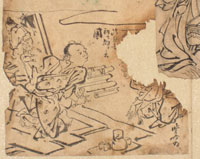
Click here to view image full size.
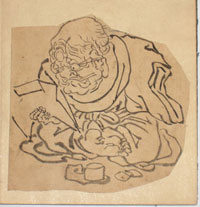
Click here to view image full size.

Click here to view image full size.

Click here to view image full size.

Click here to view image full size.

Click here to view image full size.

Click here to view image full size.

Click here to view image full size.

Click here to view image full size.

Click here to view image full size.

Click here to view image full size.

Click here to view image full size.

Click here to view image full size.
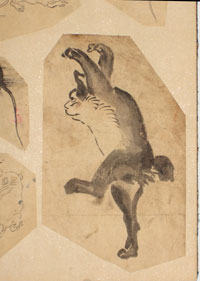
Click here to view image full size.

Click here to view image full size.
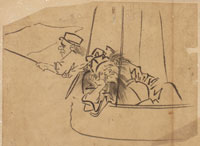
Click here to view image full size.
Nagasawa ROSETSU ( 1754-1799 )

Click here to view image full size.
An original painting showing a white mouse and a spiny lobster on a tray. Rosetsu is considered one of the most important artists of the late Edo period but little is known of his short life ( he died at forty-five ) apart from the fact that he studied, and was one of the top disciples, of Maruyama Okyo. He is labelled an “eccentric” painter as he defies easy classification. His brushwork is a tour de force and he is known for his expressive depictions of animals. The Chinese-style inscription above is by Rosetsu’s friend Minagawa Kien who was a painter and scholar of Confucianism. It implies that the lobster and mouse are both signs of good fortune. Ink and light colour on paper. Image size 44.75 x 11.25 in; 113.75 x 28.5 cms.
Signed Rosetsu with seal Gyo. Painted 1790s. Inscription signed and sealed Kyosai. Slight foxing, otherwise in very good condition. One of the most copied painters. See Kono, Exhibition of Nagasawa Rosetsu, Chiba City Art Museum, 2000, pl. 42 for identical seals. Tsuji Nobu, Nagasawa Rosetsu: the Fanciful Painter, Miho Museum, 2011, pls. 19, 58-60, 67,87, 90, 91, 93 and 94.
Status: Available
Utagawa KUNISADA (1797-1861)

Click here to view image full size.
A fine and interesting original painting, full colour on silk, 11.25 x 20.25 in; 28.5 x 51.5 cms. Shows a reclining beauty looking up at a cuckoo (hototogisu) flying in clouds. The cuckoo is the harbinger of the summer months. This painting, made c 1830, reflects Kunisada’s study, together with Ikkei, of the work of Hanabusa Itcho (1652-1724). Indeed, Ikkei gave Kunisada the name Hanabusa Ittai and this painting is signed Hanabusa Itcho Kunisada ga with seal Hanabusa Ittai Kunisada no in. To the bottom left is an inscription reading “A disciple of Utagawa Kunisada drawn on request [the cuckoo].” There is a small seal but it is undecipherable.
Minor marks but in generally very good condition. Touches of gold and the gofun on the face well retained. Newly mounted with new box.
Status: Available
Utagawa YOSHIKAZU (Active c 1849-1867)
A five-sheet original drawing (hanshita-e) showing a parade of beauties before a wicker fence and blossom. Bigyoku imayo hanazoroi, “An Assortment of Modern Beautiful Gems as Flowers.” Nice brushwork on the sumptuous kimonos. Sumi with sumi wash and light touches of red on thin Japanese paper laid onto further thin Japanese paper. Each sheet signed Ichikawa Yoshikazu ga. Sold “as is” with all imperfections, but in good condition.
Status: Available
Imao KEINEN (1845-1924)

Click here to view image full size.
An original painting, sumi on paper, image size 54 x 19.5 in; 137 x 49.5 cms. A pupil of Umegawa Tokyo and Suzuki Hyakunen. Keinen was an important figure in Kyoto art circles and considered the pre-eminent kachoga (bird and flower) artist at the end of the 19th century winning many prizes at home and abroad. Best known for his 4 volume Keinen kacho gafu, “Album of Bird and Flower Pictures by Keinen” published 1891-2. Shows two peacocks standing on a rocky outcrop. Peacocks were a popular subject for artists who could display their prowess at painting, the results often being sumptuously rendered. However, Keinen opts for a freer style in sumi only. Keinen was also known as a keen horticulturist and a bonsai expert. Original kiri wood box inscribed by him on the inside of the lid and guaranteeing the painting as being genuine. Outer lacquer box. In very good condition. Signed Keinen with seal.
Status: Available
Ichiunsai KUNIHISA (1832-1891)

Click here to view image full size.
An original painting, full colour on paper with the black waistband heavily lacquered, image size 48 x 11 in; 122 x 28 cms. Shows a young beauty carrying a box. She wears an apron and has a towel slung over her shoulder, so is presumably an assistant in a kitchen or bathhouse or similar establishment. The narrow format enhances her natural elegance. Kunihisa was the pupil and son-in-law of Kunisada. Some repaired wormage, otherwise good condition. Signed Kunihisa ga with two indistinct seals.
Status: Available

Click here to view image full size.
Yamamoto FUJINOBU (Active 1750-1770)

Click here to view image full size.
An original painting, full colour on paper, image size 32.25 x 7 in; 82 x 18 cms. Shows a parading courtesan with her kamuro. A painter and print artist whose prints were always published by Yamamoto Fusanobu giving rise to the theory that Fujinobu was a pseudonym of the publisher. Much influenced by Harunobu. His prints are extremely rare. Slight creasing, otherwise good condition. Signed Fujinobu ga with indistinct seal.
Status: Available

Click here to view image full size.
Utagawa TOYOKUNI I (1769-1825)
An original drawing by the first Toyokuni. An hanshita-e diptych for a published set of triptychs with title: Yakusha juni tsuki, “Actors in the Twelve Months.” Shows the actors (from the left) Bando Mitsugoro III holding a pipe; Iwai Hanshiro V with an open book; Nakamura Utaemon III about to write a poem; and Segawa Roko IV with another pipe. They are compared to the months of the year, in this case July, the month of the Bon Odori festival and are also a parody of the Six Immortal Poets. The print published by Yamashiroya Toemon (active c. 1801-1817). In fact this set was published Spring, Bunka 6 (1809). Sumi on thin paper laid around edges onto another sheet. Some pentimenti and also shows the initial hurried under-drawing and with annotations for the finished print. Sold together with the two published sheets which shows the lanterns removed at top, the brazier bottom centre and other minor changes. In indifferent condition. An illustrated example of this complete triptych is in the Austrian Museum of Applied Arts.
The print signed Toyokuni ga. Original hanshita-e by Toyokuni I are extremely rare. Sold “as is” with all imperfections.
Status: Available
Toba HIROMARU (Active 1804-1818)

Click here to view image full size.
An original painting showing a parading courtesan. Sumi and colour on paper, 45.5 x 11.25 in; 115.5 x 28.5 cms. A rare artist of the Utagawa school. Probably a pupil of Utagawa Toyohiro. His extant paintings show a considerable talent with particularly attenuated faces. Another example is in the MFA, Boston, acc. no. 11.7369 as well as there having been two sold at auction: Christies, NY 16/9/2003, lot 153 and Bonhams NY 18/3/2015, lot 3010. Some minor marks and creasing, but otherwise good condition. Signed Toba Hiromaru hitsu. Seal unread.
Status: Available

Click here to view image full size.
Utagawa KUNIYOSHI (1797-1861)

Click here to view image full size.
2 vols. complete: Kanjaku tsuizen hanashidori, “The Liberated Birds: A Memorial Book for Kanjaku.” A memorial book for the actor Nakamura Utaemon who died in 1852. He had the literary name of Kanjaku, meaning ”playing with sparrows” and the covers and many illustrations allude to this custom of releasing birds at funerals. Vol. 1: 1st preface , 3pp. giving the biography of Utaemon IV; poem 1p. 3 sheets: calligraphy (in ishizuri), 1p.; illustrations in colour, 5pp. signed on first page Toyokuni (III). Sheets 1-8: 2nd preface, 5pp., remaining pp. text, poems and colour illustrations. Sheets 1-75 with 15 single-page and 62 double-page illustrations in sumi and light colour. Inside back cover: colophon dated Kaei 5 (1852). Vol. 2: 110 sheets of text, poems, and illustrations. 38 single-page and 50 double-page illustrations (many in colour and includes a double-page illustration by Kuniyoshi). Last page, colophon, dated Kaei 5 (1852). Original covers with clouds and sparrows. Some soil and minor damage. One title slip missing and other damaged. Contents extremely good.
Status: Available
Utagawa HIROSHIGE (1797-1858)
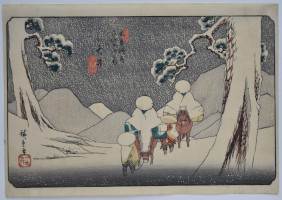
Click here to view image full size.
Oi, a suburb of present day Ena City, is in the southern foothills of the central mountain range now known as the Japan Alps. Shows a group of travellers heavily protected against the snow and cold. From Kisokaido rokujukyutsugi no uchi, “Sixty-Nine Stations of the Kisokaido.” The set of seventy prints was started by Eisen and published by Hoeido in 1835, but in 1837 Hiroshige took over and completed the series with the publisher Iseya Rihei (Kinjudo). One of Hiroshige’s most famous designs.
Very good impression and colour. Imperceptible centre fold, otherwise very good condition. Signed Hiroshige ga.
Status: Available
Utagawa KUNISADA II (1823-1880)
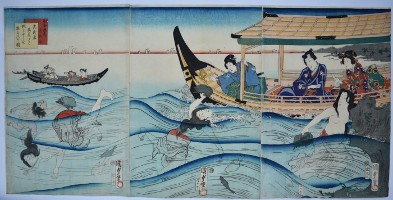
Click here to view image full size.
A triptych showing Prince Genji in a boat with attendant page and a lady watching female awabi (abalone) divers called ama. These women were a great curiosity for the public and seen as rather risqué characters. Prince Genji was the protagonist of Murasaki Shikibu’s Heian-era novel The Tale of Genji. He was the second son of the emperor, and relegated to civilian life. Published 1865 by Maruya Kyushiro.
Very good impression and colour. Slight edge soil, otherwise very good condition. Signed Kunisada hitsu.
Status: Available
Utagawa SADAFUSA (Active 1830s – 1840s)

Click here to view image full size.
An original sumi woodblock for two chuban prints from a Kanadehon Chushingura set. The upper design being Act VII, the tea-house Ichiriki, Kyoto with Yuranosuke; the lower showing Act VIII, the bridal journey with Konami and her daughter Tonase on the Tokaido Road. Sold “as is” with all imperfections.
Status: Available
Utagawa KUNISADA (1786-1864)

Click here to view image full size.
An original hanshita-e (preparatory drawing) for a triptych showing, from the left, Nakamura Kamenojo I as the geisha Azuma standing above Kawarasaki Gonjuro I as Yamazakiya Yogoro, Bando Kamezo I as Settanaoshi Chogoro standing above Onoe Kikugoro IV as Kumasaka Ocho, and Onoe Kikugoro IV as Akogi Gennojo standing above Onoe Kikujiro II as Onnadayu Okoyo. The play was Yume musubu cho ni torioi performed at the Ichimura-za theatre 3/1856. These first drafts by the artist themselves survive because a more detailed drawing was needed by the blockcutter, and this was normally given to an assistant to execute. Or the drawing was never taken up by the publisher, for whatever reason. Sumi and touches of red with some pentimenti. (This was also most likely a published print by Sanoki as it is from the same group as others offered here.) Signed on two sheets Toyoukuni ga.
Status: Available
Kawamura BUMPO (1779-1821)

Click here to view image full size.
I volume complete Bumpo gafu (Sampen), “Album of Drawings by Bumpo” (3rd Series”). Original light grey covers with burnished pattern. Original title slip. Preface 3 pp., with 18 double-page and 32 single-page illustrations in sumi and light colour numbered 1 – 35. Colophon dated Bunka 10 (1813).(First edition.) Signed Bumpo with publishers Kawachiya Kihei and Yoshidaya Shimbei. Fine impressions. Very good condition with no thumbing to corners.
Status: Available
Hosoda EISHI (1736-1829)

Click here to view image full size.
An original painting, sumi and colour on silk, 33.25 x 12 in; 84.5 x 30.5 cms. Shows a parading oiran, a high class courtesan, beneath falling cherry blossom. A parade was held every April in the Yoshiwara under the spring cherry blossom. Her costume is decorated with a large golden koi swimming amongst water weeds. An elegant and refined painting of great delicacy typical of this painter who was of unusually high rank for an Ukiyo-e artist. His prints – usually of beauties – are equally elegant. He also had a considerable number of pupils, including Eisho, Eiri and Eisui who produced some exceptional compositions. Probably painted around 1795-1804.
Mount with some minor damage; painted area in very good condition. Signed Chobunsai Eishi hitsu with Eishi seal.
Status: Available

Click here to view image full size.
Toyohara KUNICHIKA (1835-1900)
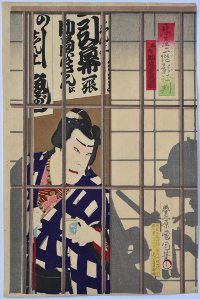
Click here to view image full size.
The actor Suketakaya Takasuke IV as Sakuramaru from a fine set of prints showing actors glimpsed through their dressing room sliding doors, prior to going on stage. Their figures partly silhouetted as are their assistants, here aiding the actor with his sword. From a set Gakuya nikai kage no hyoban, “Popularity of the Upstairs Dressing Room.” The set published by Takagawa Fusajiro, 1883.
Fine impression, colour and condition. Full size. Signed Toyohara Kunichika hitsu.
Status: Available
Toyohara KUNICHIKA (1835-1900)

Click here to view image full size.
The actor Onoe Kikugoro V as Hisayoshi from a fine set of prints showing actors glimpsed through their dressing room sliding doors, prior to going on stage. Their figures partly silhouetted as are their assistants, here aiding the actor with his costume. From a set Gakuya nikai kage no hyoban, “Popularity of the Upstairs Dressing Room.” The set published by Takagawa Fusajiro, 1883.
Fine impression, colour and condition. Full size. Signed Toyohara Kunichika hitsu.
Status: Available
Utagawa KUNITERU (Fl. mid-19th c.)

Click here to view image full size.
An original hanshita-e (preparatory drawing) for a triptych showing the ground floor interior of a brothel in the Yoshiwara with courtesans and their assistants. These first drafts by the artist themselves survive because a more detailed drawing was needed by the blockcutter, and this was normally given to an assistant to execute. Or the drawing was never taken up by the publisher, for whatever reason. He was a pupil of Kunisada, originally calling himself Sadashige, and becoming Kuniteru when Kunisada became Toyokuni III. Sumi and touches of red. Extensive pentimenti. Sold “as is” with all imperfections. Signed on two sheets Kuniteru ga.
Status: Available
Utagawa KUNISADA (1786-1864)
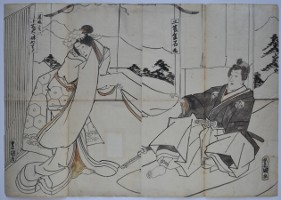
Click here to view image full size.
An original hanshita-e (preparatory drawing) for a published diptych showing, on the left, the actor Onoe Kikujiro II as Tatsuhime – in reality Yawata, the younger sister of Kotoda. On the right is Iwai Kumesaburo III as Kudo Kanaishimaru. The play is Matsu icho Tsurukame Soga performed at the Nakamura-ya theatre, 1/1854. The publisher of the print was Sanoki. These first drafts by the artist themselves survive because a more detailed drawing was needed by the blockcutter, and this was normally given to an assistant to execute. Or the drawing was never taken up by the publisher, for whatever reason. Sumi and touches of red. Signed Toyokuni ga on both sheets. Sold “as is” with all imperfections.
Status: Available
Kawabata GYOKUSHO (1842-1913)

Click here to view image full size.
An original painted fan. On one side a bird amongst flowers and the reverse also with flowers. A leading figure in Tokyo art circles and the last great representative of the Shijo school. In exceptional condition with extensive gold leaf. Signed Gyokusho with seals Shibun on both sides.
Full colour on silk, each panel 39.75 x 25 in; 101 x 63.5 cms. Extremely good condition. Signed Kinzaburo Yoshitoshi ga with blurred seal but reading Go Kaisai. Extremely rare.
Status: Available
Cho GESSHO (1772-1832)
Click here to view image full size.
A large original painting of moored junks caught in a violent squall. A fine painter who studied under Tanke Gessen and Matsumura Goshun in Kyoto before moving to Nagoya in 1798 and becoming Nagasawa Rosetsu’s assistant for a short time. Also illustrated some fine ehon. Sumi and colour on silk with the currents of air painted in gold; 55.25 x 26 in; 140.25 x 66 cms. Painted c. 1810s. Provenance: Two previous owners’ seals on the exterior of mount: The Honda family library and the Ueno family. Old box with inscription which states that Gessho wanted to acquire a painting from the Owari district. Although not intrinsically valuable it was esteemed by the local people. He offered to exchange the painting offered here for their painting. There is a dig here in that the inhabitants of Owari were known to be avaricious. Written by Mizutani Okurei (1848-1926). Presumably based on the accounts of the two previous family owners.
Signed Gessho with seal: Yukisada, Genkei, Gessho. Obviously an important painting by Gessho and in very good condition.
Status: Available
Utagawa KUNIYOSHI (1797-1861)
Click here to view image full size.
Gempei Yashima o-kassen, the great battle of Yashima in 1184. Shows Yoshitsune’s famous “eight-boat leap” (centre), Noritsune (left), and Benkei on the large boat (right). Published by Kawaguchiya Uhei, c. 1839-41.
Very good impression and colour. Edge repair top left sheet, otherwise very good condition. Signed Ichiyusai Kuniyoshi ga.
Status: Available
Onishi CHINNEN (1792-1851)
Click here to view image full size.
One volume complete Azuma no teburi, “Customs of the Eastern Capital”. Published Bunsei 12 (1829). Original covers, light blue-grey with silver stencilled decoration. Original title slip (damaged). Inside front cover title Taihei Uzo (the original title). Artist: Chinnen, and publisher Sonando. 25 double page illustrations showing the inhabitants of the capital going about their daily pursuits. Inside back cover: Colophon, dated Bunsei 12 (1829) and publishers Kobayashi Shimbei and Osakaya Gembei. Slight repared wormage and minor marks, but generally a nice copy of a fine shijo book.
Status: Available
Matsumura KEIBUN (1779-1843)
Click here to view image full size.
A shijo brush drawing of a seabream and a lumpfish (?). One of Kyoto’s leading artists. Noted for his painting from nature. He studied with his older brother Matsumura Goshun as well as Maruyama Okyo. Sumi and light colour on paper, 10 x 14.75 in; 25.4 x 37.4 cms.
In good condition. Signed and sealed Keibun.
Status: Available
Matsumura KEIBUN (1779-1843)
Click here to view image full size.
A shijo brush drawing of a white horsehead and an acropomatidae (?). One of Kyoto’s leading artists. Noted for his painting from nature. He studied with his older brother Matsumura Goshun as well as Maruyama Okyo. Sumi and light colour on paper, 10.5 x 15 in; 26.7 x 38.1 cms.
In good condition. Signed and sealed Keibun.
Status: Available
Matsumura KEIBUN (1779-1843)
Click here to view image full size.
A shijo brush drawing of a red seabream. One of Kyoto’s leading artists. Noted for his paintings from nature. He studied with his older brother Matsumura Goshun as well as Maruyama Okyo. Sumi and light colour on paper, 10.5 x 17 in; 26.7 x 43.2 cms.
In good condition. Signed and sealed Keibun.
Status: Available
Matsumura KEIBUN (1779-1843)
Click here to view image full size.
A shijo brush drawing of a gurnard and a snapper (?). One of Kyoto’s leading artists. Noted for his painting from nature. He studied with his older brother Matsumura Goshun as well as Maruyama Okyo. Sumi and light colour on paper, 10.5 x 17.75 in; 26.7 x 45.1 cms.
In good condition. Signed and sealed Keibun.
Status: Available
Nishiyama HOEN (1804-1867)
Click here to view image full size.
An original painting showing the oiran Eguchi on a white elephant. The origins of this story seem to go back to a recorded conversation the poet-monk Saigyo (1118-1190) had with a prostitute named Eguchi giving rise to numerous legends. Eguchi is shown as a manifestation of the Budhisattva Fugen whose usual vehicle is a large white elephant. Hoen, one of the best shijo painters of his time, lived in Osaka and was a pupil of Keibun. Full colour on silk, 36.5 x 13 in; 92.7 x 33 cms. Mount showing signs of wear but image in good condition. Signed Hoen with seal (?) – Seisho.
Status: Available
Yanagawa SHIGENOBU (1787-1833)
Click here to view image full size.
An original painting by this artist who was the pupil and then son-in-law of Hokusai. He was given the name Yanagawa (from his residence in the Honjo district of Edo) to distinguish him from other Shigenobu artists. A good book illustrator and surimono designer. He designed the first square surimono in Osaka in 1822, inspiring others to follow. His paintings are rare. Shows a portrait of the Japanese scholar and writer Ishikawa Masamochi (1754-1830). The fifth son of Ishikawa Toyonobu, he was a renowned kyoka poet and Gesaku writer (playful, mocking works), including The Magical Carpenter of Japan. An important figure in kyoka/surimono circles. Known as Rokujuen (Yadao no Meshimori). His family crest is seen on his kimono and he sits before a low desk ready to write. A high quality painting, sumi and colour on silk, 29 x 12.5 in.; 73.6 x 31.8 cms. Several small backed wormholes at bottom, otherwise very good condition. Would benefit from being remounted.
Signed Shigenobu with seal Yanagawa.
Status: Available
Toyohara KUNICHIKA (1835-1900)
Click here to view image full size.
The actor Onoe Taganojo II from a fine set of prints showing actors glimpsed through their dressing room sliding doors, prior to going on stage. Their figures partly silhouetted as are their assistants, here aiding the actor with his headpiece. From a set Gakuya nikai kage no hyoban, “Popularity of the Upstairs Dressing Room.” The set published by Takagawa Fusajiro, 1883.
Fine impression, colour and condition. Full size. Signed Toyohara Kunichika hitsu.
Status: Available
ANONYMOUS (Late 18th century)
Click here to view image full size.
An Uki-e, “floating picture” painting showing an interior with a puppet performance taking place. A puppeteer manipulates a female puppet in the centre, behind him two gidayu narrators and a shamisen player. A male puppet is being held behind a screen. Ladies behind a screen at right enjoy the drama. In fact, a male individual at the back seems overcome by emotion with a hanky to his face. The architecture is represented using one-point perspective, a style which made its way to Japan in the 1740’s from the West via China. (Interestingly the artist has got the perspective wrong on the screen at right.) This genre of painting – invariably unsigned – always shows interior or semi-interior views with banquets or, as here, puppet performances. Full colour on paper, 17 x 23 in; 43.2 x 58.5 cms. Minor marks, although good condition for this kind of painting.
Status:
Available

Click here to view image full size.
Tsukioka SETTEI (1710-1786)
Click here to view image full size.
An original painting, sumi and light blue on silk. Image size 38.75 x 14.25 in; 98.4 x 36.2 cms. Shows a carp leaping a waterfall. This was a favourite subject for Japanese artists being a symbol of achievement against adversity. Carp were bred for their colour in Japan and, interestingly, Koi that are returned to the wild revert back to their grey colour. They are known to live for up to a hundred years or more. Settei produced many illustrated books but after around 1765 turned to painting beauties, courtesans and geishas. They are of the utmost refinement – the faces and limbs picked out in red, their costumes with areas of gold, and invariably have the wide lantern-locks (toro-bin) hairstyle. Signed Hogen Tsukioka Sessai jinen rokuju-nana (painted aged sixty-seven, hence 1777). Seal Masanobu no in. In good condition with splashed gofun.
Status: Available
Ohara HOSON (Aka SHOSON, KOSON) (1877-1945)

Click here to view image full size.
A rooster and weasel. Published by Kawaguchi, c. 1930. The first and only edition. Ex Robert O. Muller collection. Rare.
Very fine impression, colour and condition. Signed Hoson. Copyright seal in lower right margin; seal of printer, Komatsu, and carver, Maeda, in lower left margin.
Status: Sold
Utagawa HIROSHIGE (1797-1858)

Click here to view image full size.
The extremely rare first, private printing of Bora, the grey mullet (Mugil cephalus) with camellia and Japanese asparagusado. From a set of 10 prints in folding album form, privately commissioned for a poetry club, c 1832-34. Poems by Higaki Kunifune and Toshinoto Haruki. The judges’ names next to the poems. These were removed on the commercial editions. Rare because of the obvious reason that the numbers printed were directly related to the relatively small memberships of poetry groups.
Fine impression and colour of the earliest printing without kiwame seal and publisher’s seal. With judges’ names and without gradation at top. Centre fold (as always), otherwise very good condition. Signed Ichiyusai Hiroshige ga. Unknown collector’s seal au verso.
Status: Sold






